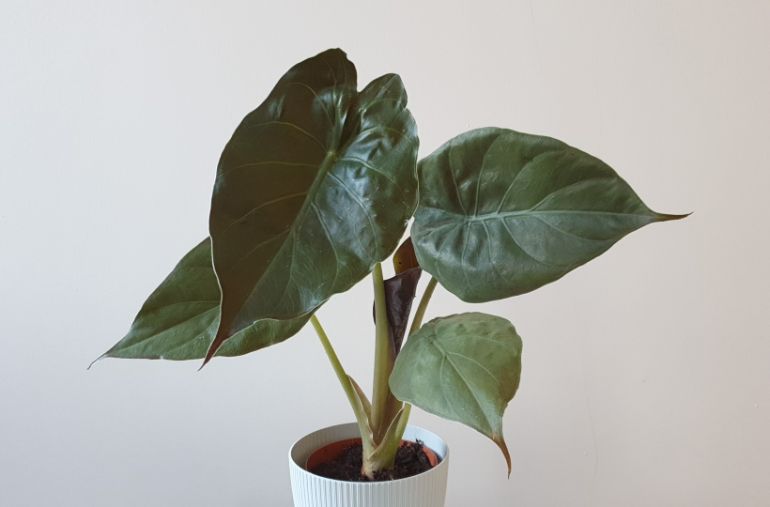The stately Alocasia wentii is equally striking as a jungle backdrop or an exotic centerpiece. Though it is one of the easier varieties of Alocasia, it’s still not a beginner’s plant. Let’s review everything you need to know about Alocasia wentii care to keep your plant thriving and avoid the pitfalls.
Alocasia wentii likes bright indirect light, high humidity, damp, well-draining soil, and temperatures of 55-86ºF (13-30ºC). It’s a heavy feeder that does well when slightly rootbound. It’s prone to spider mites and thrips and tends to go dormant if temperatures drop or light decreases.
Alocasia Wentii Overview
Alocasia wentii’s glossy green leaves have its family’s classic broad shape and feature a slightly ruffled texture and purple-hued undersides. The stunning color beneath the leaves is an adaptation to the mottled light of its native Asian rainforest floor.
Alocasia wentii goes by a few common names, including “Purple Umbrella,” “New Guinea Shield” and, encouragingly, “Hardy Elephant Ear.” It is thought to be a hybrid between Alocasia Ordora and Alocasia Gageana.
The plant grows briskly in good conditions and grows to about three feet high and wide; its broad leaves can reach over a foot in length. The warmth-loving Wentii can remain evergreen but goes dormant in cool weather. It makes an excellent houseplant and is also a suitable outdoor landscape plant in warm, humid climates.
Alocasia Wentii Care Summary
| Scientific Name | Alocasia wentii |
| Common Name | New Guinea Shield, Purple Umbrella, Hardy Elephant Ear |
| Origin | New Guinea |
| Light Requirements | Needs mainly bright, indirect light, but can tolerate a little direct sunlight in the late afternoon or early morning. Consider using a grow light in winter to prevent dormancy. |
| Watering | Maintain lightly moist conditions. Water thoroughly once the top inch of soil feels dry. Make sure to let your plant drain well after watering. Very prone to root rot if overwatered, but cannot tolerate dry soil. |
| Soil | A specialist Aroid mix is the best option. This is the one I use. It contains coconut coir, LECA, perlite, charcoal, bark chips, and worm castings. Alternatively, equal parts of cactus mix and a standard houseplant potting mix will do OK. |
| Temperature | Tolerates temperatures of 55ºF (13ºC) to 86ºF (30ºC). Cooler conditions will trigger dormancy, and the plant starts to suffer above 95ºF (35ºC). |
| Fertilizer | Alocasia wentii has quite high fertilizer requirements. Feed monthly during the growing season. I use a balanced fertilizer diluted to half the recommended strength. Avoid fertilizing in winter. |
| Humidity | High humidity is important for good Alocasia wentii care. >60% is strongly recommended, but it may tolerate as low as 40% in some circumstances. Watch out for brown leaf edges and tips as warning signs of low humidity. |
| Flowering | Produces unimpressive pale-colored spathes that only last a few days. |
| Pruning | Prune damaged or dead leaves off as required. Take care not to damage new leave emerging from the stem when pruning. |
| Propagation | Propagate by division. Alocasia wentii produces new offsets and corms from its rhizome, which can be divided when repotting. |
| Re-Potting | Only repot when significantly rootbound. Spring is the best time to repot. Alocasia wentii is easier to care for when fairly snug in its pot. Avoid excessive disruption of the roots when repotting. |
| Diseases and Pests | Spider mites and thrips are common. Fungal leaf diseases and root rot are encouraged by warm, wet conditions. |
| Toxicity | Alocasias are poisonous to humans, dogs, cats, and horses. The plant contains oxalic acid which forms intensely irritating calcium oxalate crystals. The sap can also cause dermatitis, so consider wearing gloves when handling your plant. |
| Where To Buy | Buy Alocasia wentii online at Etsy (I buy most of my houseplants from Etsy). |
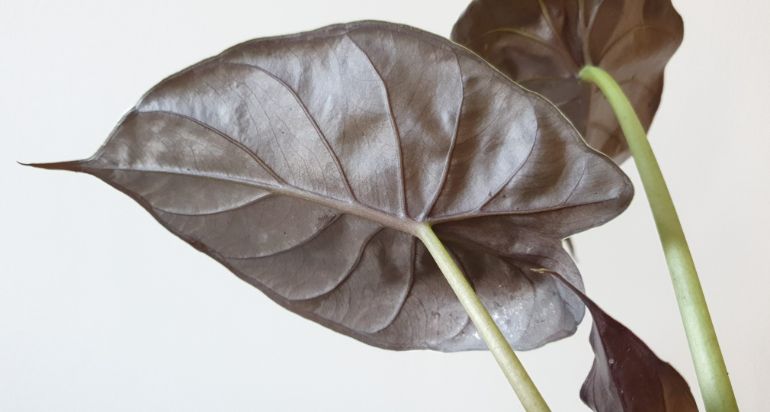
Alocasia Wentii Light Requirements
Alocasia wentii thrives in bright, indirect light but scorches quickly if the rays are too intense. The species has some adaptability to lower-than-ideal illumination, but it will stretch and become spindly if the light is too dim.
A foot or two back from a sunny window is often a great spot. Some mild direct sun in the early morning or late afternoon can usually be tolerated; the Wentii thrives under artificial sources, too.
Check out my article on lighting for houseplants and consider measuring the light in your home with a light meter app to find the perfect spot for your plant.
How To Water Alocasia Wentii
Watering is a crucial aspect of Alocasia wentii care. They like their soil to remain consistently slightly damp without ever becoming soggy. They are thirsty plants, too, especially outside – landscape Alocasias may need almost daily soakings in hot weather.
Let the top one to two inches of soil dry out, according to the pot’s size. Alocasia wentii is sensitive to overwatering and easily develops fatal root rot in boggy soil: having a brief period of partial drying helps curb disease and fungal issues.
Never let the soil go completely dry, however. The plant may droop if underwatered, but this is a warning of desiccation and not a friendly reminder – don’t wait for this plant to “tell” you when it needs water.
If you’re struggling with this aspect of Alocasia wentii care, you can learn some helpful houseplant watering tips in this article.
At watering time, make a practice of flushing the soil with extra water and letting the excess drain. This ensures the entire root system is saturated and washes out contaminants such as unused fertilizers.
Note: Try not to water too near the fleshy stem of the plant, which is particularly vulnerable to stem rot.
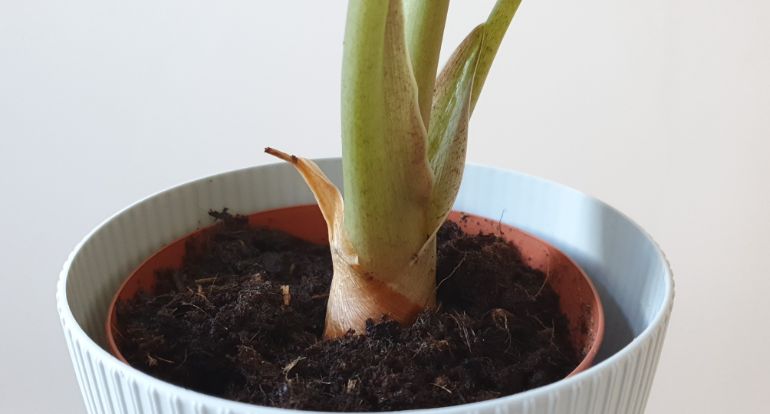
Alocasia Wentii Soil Requirements
It’s debatable which is more important to your Alocasia wentii’s health: soil or watering. They are interrelated – it is very difficult to water this plant properly if it’s in the wrong mix.
The best soil is fertile and well-draining. The mix needs to have a strong structure that supports superior aeration while still holding a modest amount of water. Organic material is a good way to build the right consistency and add fertility.
Soilless gardening has attracted a lot of attention because so many desirable tropical plants do notably well in airy combinations of coco coir, peat moss, perlite, etc. – mixes that don’t include “traditional” soil at all. An Alocasia wentii can prosper in a soilless mix if it receives sufficient nutrition.
Here are tips for your Wentii’s soil:
- A quality Aroid soil is generally recommended for Alocasia wentii. I use a pre-made aroid mix comprising coconut coir, LECA, perlite, charcoal, worm castings, and bark. I usually purchase pre-made aroid mix from Etsy (Link to Etsy).
- An alternative is to use equal parts of standard houseplant potting soil and cactus soil mix. This will do the job OK as long as you take care with watering.
- Organic materials like compost or worm castings are excellent soil additions, that help improve soil fertility and create a healthy microbial population. 10% of one of these added to your potting mix is a good option but will increase water retention and decrease drainage slightly.
Alocasia Wentii Humidity Requirements
True to its tropical rainforest origins, Alocasia wentii loves humidity. The plant may struggle through lower humidity conditions, but it will be prone to becoming lackluster and developing brown, dry areas on its leaves.
Some Alocasias cope with low humidity better than others. Alocasia wentii is one of the more tolerant varieties – but they pose a challenge for those living in dry climates. 60% humidity or above is recommended for your Alocasia wentii … some growers report success down to about 40%, but that’s pushing it.
Even if your plant puts up with average humidity, it will probably flourish even more with higher levels. Here are ways to increase humidity indoors:
- Group plants together (especially other tropical plants).
- Use pebble-filled water trays under the plant’s container or close by.
- Locate the plant in an area that gets a regular influx of steamy humidity, like a bathroom, laundry room, or kitchen.
- Use a room humidifier. Be aware that very high levels of humidity can trigger mold on the walls – probably not the botanical addition you want to make to your home.
- Read my article on increasing humidity for your houseplants to learn more.
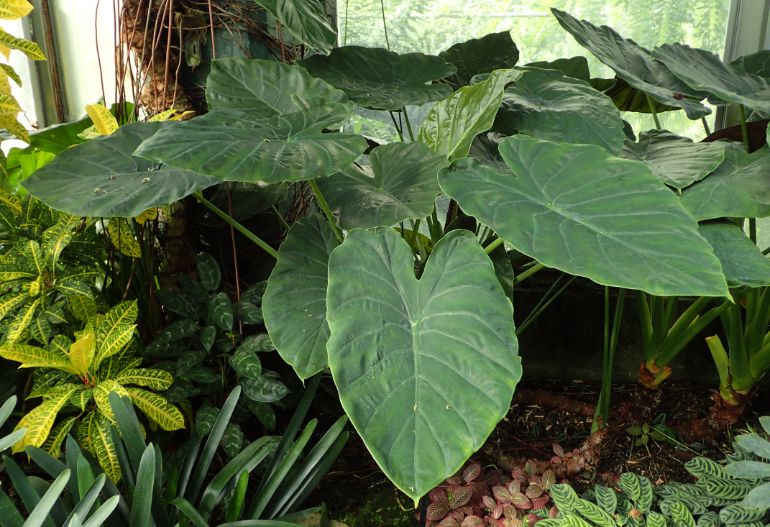
Alocasia Wentii Temperature Requirements
Alocasia wentii couldn’t be more accommodating about temperatures: they like a comfortable range from 55ºF (13ºC) to 86ºF (30ºC). Cooler conditions will trigger dormancy, and the plant starts to suffer above 95ºF (35ºC).
It’s common to grow a potted Alocasia wentii outdoors in spring and summer and bring it inside before temperatures fall. They grow outdoors year-round in warm climates and will naturally go into dormancy if the weather cools … but they won’t survive a severe freeze.
How To Fertilize Alocasia Wentii
This plant can be a heavy feeder during the growing season, so you want make sure it has nutritional support. It’s easy to overfertilize, so don’t go overboard.
Root inhibition and damage from too much fertilizer typically shows up as discoloration on the leaves. The tips often turn brown.
Feed monthly during the growing season with fertilizer diluted to half the label’s recommendation. Take into account the fertility of the plant’s soil.
Tips:
- If you choose to use a dry or granulated fertilizer, apply at least six inches from the plant’s base.
- Organic fertilizers like fish emulsion or worm tea are safer for sensitive roots than synthetic formulas and don’t need as much dilution.
- Flush the soil with every watering by running extra water through the soil and out the drain. This helps rinse away unused fertilizer.
- Don’t feed during the winter. Taper off as growth slows.
- Read my article on fertilizing houseplants to learn everything you need to know about this important aspect of houseplant care.
Spathe Flowering
Alocasia wentii isn’t grown for its blossoms, but it produces tasteful spathe flowers. More formally called an inflorescence; the spathe is short-lived and expires within days.
To conserve the plant’s energy, cut the flowers as they begin to fade. If not, the modest blooms soon dry up and turn brown; deadheading is advised.
Pruning Alocasia Wentii
The primary reason to prune an Alocasia is to remove damaged leaves or trim it back; the plant can’t be shaped through strategic cuts like topiary. A growing Alocasia wentii has a higher turnover of leaves than many plants, so it quickly replaces trimmed leaves.
Remove leaves from the base of the stem, but take special care not to injure baby leaves still forming. Each Alocasia leaf produces the next one, so leave a short stump that spares the forming leaf and avoid chopping the old and new leaves off together.
Make sure to use sterilized blades when pruning to reduce the risk of disease!
Repot When Seriously Rootbound
Repotting is a pretty invasive act from the plant’s perspective, so try to be gentle. It will normally take your plant at least 4-6 weeks to recover after repotting.
Fortunately, you don’t have to repot often. Like most Alocasias, the Wentii likes being overgrown in a snug container. The plant can grow quite large in a small pot and still be happy … but it should be repotted once seriously rootbound.
Spring is the time to repot your Alocasia wentii (if it’s needed). This gives the plant ample growing time to recover. Avoid repotting during dormancy. You can read this article for a step by step guide to repotting your plant.
Don’t increase the size of the pot by more than an inch or maybe two. A pot too large for your Alocasia’s root system will slow top growth as the plant dedicates its resources to root exploration.
Another and potentially more serious problem with an oversized pot is that the extra empty soil causes it to dry more slowly, which makes it harder to water properly. Continuing with the same watering schedule after repotting can lead to overwatering and root rot.
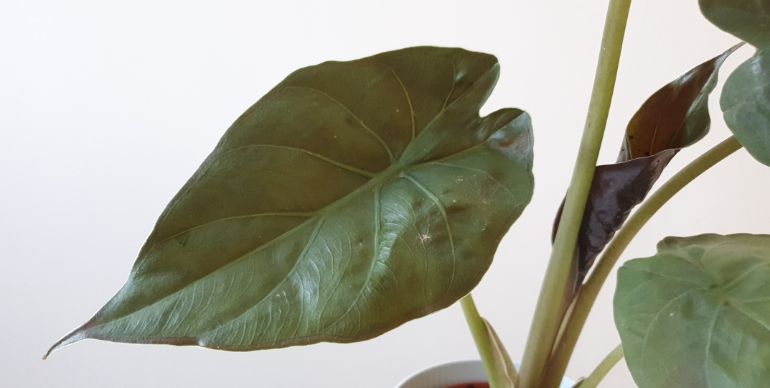
How To Propagate Alocasia Wentii
Division is the primary method of propagating your Alocasia wentii.
Alocasias don’t grow from cuttings as a rule. You can technically grow Alocasias from seed, but reputable sellers are hard to find and the seeds must be planted when fresh in order to germinate – like fresh from the berry itself.
Division is much easier and quicker. Alocasia wentii grows from a rhizome that produces offsets and corms that can be removed from the plant and grown separately. You can also divide the rhizome into sections for sprouting, but that means dismantling the mother plant.
Here are the steps for propagating through division:
- The best time to divide is during a spring repotting when the roots are already disturbed.
- Water thoroughly about 24 hours before repotting. Well-hydrated root hairs are more flexible and resilient to damage.
- Gently unpot the mother plant. Delicately shake or wash the soil from its roots.
- Look for small clumps, or corms, or offsets. Typically these have tiny roots that are tangled with the larger plant.
- Tease the root systems carefully apart; avoid tearing them. If necessary, cut apart using a tool sterilized with isopropyl (rubbing) alcohol.
- You can grow the new plantlets in soil or water, but the most common method is in soil. There is evidence that roots sprouted in water don’t function efficiently in soil, so if you intend to transplant them into a pot there will be an additional period of transition.
- Give the new plants a warm location with good indirect light, elevated humidity, and soil that is consistently damp but never soggy. You should see new growth within a few weeks.
High Toxicity
Alocasias are typically poisonous to humans, dogs, cats, and horses. The plant contains oxalic acid which forms intensely irritating calcium oxalate crystals.
Symptoms start with a oral burning sensation that can lead to vomiting, drooling, and difficulty in swallowing. Death is rare but can happen if swelling tissue blocks all airways.
The sap of Alocasia wentii is also toxic and can cause irritation or dermatitis, so wear protection when handling the plant.
Alocasia Wentii Care Tips
- Alocasia wentii tends to be a thirsty plant, especially in warm weather. It needs less water when kept inside.
- Water consumption soars during leaf production. To avoid a plant-damaging dry spell, water more frequently and monitor the soil daily.
- Higher humidity allows Alocasia wentii to tolerate more intense light.
- Your Alocasia wentii is slow to adapt to change, so expect to lose some leaves after bringing her home or a major relocation. Don’t overreact and move the plant again to “find the right spot.”
- Like most tropicals, an Alocasia wentii leans towards a light source. Rotate the plant regularly to prevent it from becoming lopsided: just give the pot a quarter-turn clockwise every time you water.
Varieties
There are almost 80 species in the Alocasia genus, but only one Wentii.
Pests
Alocasias have a reputation as pest magnets, but this is mainly due to two villains: spider mites and thrips. Other pests can pose problems but are less common.
Infestations can develop quickly, and it can be so disappointing for perfect Alocaisa wentii care to be ruined by a pest infestation. Inspecting for pests when you water is an excellent habit.
These pests can hide under leaves and in joints and crevices, so check these areas carefully.
Spider mites are almost too small to see – a magnifying glass is helpful and will keep you from panicking over every stray grain you see. Look for telltale tiny webbing on the foliage and stems.
Thrips look like teeny dark slivers on the leaves. Their damage is easier to see: their feeding habits cause streaks and silvery patches.
Regardless of which pest has invited themselves to dinner, treatment should generally start by removing badly affected leaves and giving the plant a good shower. Knock off as many pests as possible.
Don’t forget to isolate any plant affected by pests from any of your other houseplants. Pest infestations can spread quickly, so act fast!
One of the most popular treatments for these pests is neem oil, a botanical insecticide that kills on contact. Because neem oil has mild residual effect and low environmental impact, some growers apply it to their Alocasia wentii regularly as a preventative.
Another low-toxicity treatment particularly effective against spider mites is to dust the plant with diatomaceous earth (DE). Rinse or wipe off after three days. DE must be dry to be effective and is messy to apply (use a mask), but it can safely knock down even a severe infestation.
Disease
Alocasia wentii care is difficult enough without having to worry about diseases too. Fungal issues are the most common disease you’ll see, and most are moisture-related and often cause discolored leaf spots.
Isolate the plant until the infection has cleared; if you move your plant, try not to change conditions too much. Small outbreaks can usually be contained by keeping the leaves dry and taking care not to overwater. Increasing ventilation helps.
If leaves have large spots or other damage, they can be safely pruned and discarded.
There are fungicides and treatments of differing effectiveness, but some infections have no effective remedy. Severely affected plants should be destroyed. You can read more about how to identify, treat and prevent common houseplant diseases in this article.
Alocasia Wentii Care Problems (And Solutions)
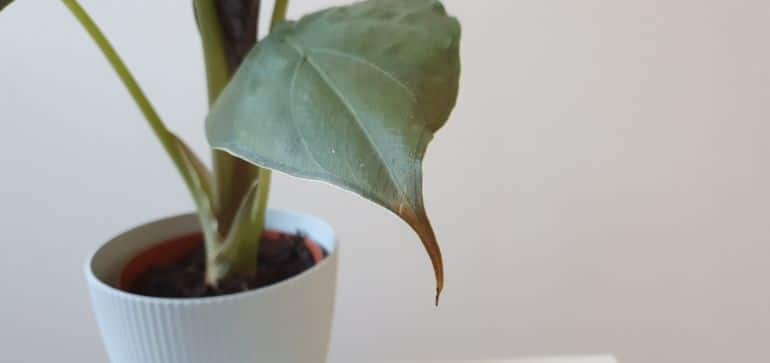
My Alocasia Wentii Lost All Its Leaves – Should I Throw It Out?
Your Alocasia will remain evergreen only as long as conditions remain warm and bright. They typically enter dormancy if temperatures drop or the light intensity decreases.
The most common triggers for dormancy are after bringing a plant in from outdoors, acclimation after first purchasing your plant, or low light and cooler temperatures in winter. Any abrupt reduction in light or temperatures can trigger dormancy.
Unfortunately, a dormant Alocasia wentii is likely to lose most or all of its leaves and become a forlorn stump – not the look most owners are striving for. If you want your Alocasia wentii to keep its leaves and avoid going dormant, keep its temperature and light range close to what it receives during the growing season.
A dormant plant isn’t sick, it’s just hibernating. Put it in a cool space and let the soil dry out a bit, and when warm weather returns you can resume normal care as the plant rebounds.
Why Is My Alocasia Wentii Getting Yellow Leaves?
The most common reason for yellowing on leaves is overly moist soil. Overwatering is also the most dangerous: yellow leaves signal conditions for root rot.
Rule out rot by inspecting the root system. Healthy roots are pale, firm, and smell of earth. If you discover root rot, you’ll need to take immediate and possibly drastic action to save the plant.
If wet soil isn’t the problem, continue looking at other common reasons for yellow leaves, namely underwatering, temperature extremes, and overly intense light. Yellowing can also happen in response to the cumulative stress of low humidity, pests, disease, nutrient deficiencies, and the repotting blues.
Why Is My Alocasia Wentii Getting Brown Leaves?
The most common reason for brown leaves on an Alocasia wentii is low humidity. This most typically causes brown leaf edges and tips. I recommend monitoring humidity with a digital hygrometer and trying to keep humidity levels above 60%.
Brown leaves can also be caused by excess light, disease, pests, overfertilizing, or a combination of plant stressors. If you see brown leaves on your Alocasia wentii, read this article for step-by-step help to work out what the problem is.
How Do I Know When To Repot My Alocasia Wentii?
Gently unpot the plant and inspect the rootball. Alocasias are ready to move to a larger space when they become seriously rootbound.
Even if the plant is ready for repotting, it should not be done until late spring or early summer.
Here are signs a Wentii is rootbound:
- Large roots are circling the inside of the pot.
- The rootball fills the pot to the point that its soil has been consumed.
- The soil has needed more frequent watering of late.
Related Articles
If you’d like to learn more about growing healthy houseplants or are having any other problems with looking after your Alocasia wentii, check out some of the following articles.
- How To Care For Alocasia Amazonica
- 13 Amazing Alocasia Varieties You Will Love
- Complete Guide to Growing Alocasia Zebrina
- Why Do Alocasia Leaves Droop? (And How To Fix It)
- How To Care For Alocasia Frydek
- How To Prevent And Fix Yellow Leaves On Alocasias
- Complete Guide To Growing Alocasia Black Velvet
- How To Care For Alocasia Dragon Scale

